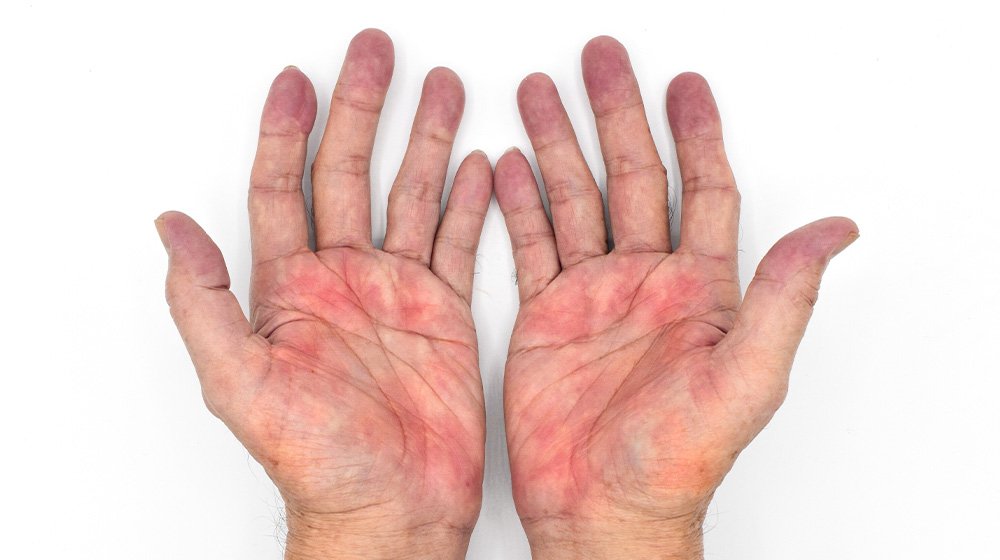Overview
Palmar erythema is an often overlooked skin condition as reddening of the skin may occur on several occasions due to various reasons.
However, except for palmar erythema that results from specific genetics, the abnormal redness is a cutaneous sign of some underlying causes, like diseases, medications’ side effects, or environmental factors.
RELATED: 5 Genius Ways to Restore Gut Health
What is Palmar Erythema?
Palmar erythema (also known as Lane’s disease) is a rare, benign skin condition in which non-painful redness appears on the surface of the palm and fingers. Some parts of the palm that are most likely affected by palmar erythema include:
- Thenar (the rounded, fleshy part at the base of the thumb)
- Hypothenar (the fleshy part that extends from the bottom of the little finger to the wrist)
- Distal palmar (the fleshy part between the base of the fingers and the upper palmar crease)
- Fingertips
Notably, the back of the hand (dorsal surface of the hand) is also affected by palmar erythema, although the probability is very rare.
The reddening is due to various reasons, yet anatomically it is due to the increased dilation of the capillaries under the hand. Palmar erythema is not an allergic reaction, so the affected areas should not be itchy (pruritic).
The redness of the palm may appear differently from time to time since the degree of redness varies depending on:
- Emotional states
- Position of the hand
- Temperature
- Pressure on the palm
- The severity of the underlying cause
What Are the Symptoms of Palmar Erythema?
The symptoms of palmar erythema include:
- Symmetrical/bilateral reddening of both hands
- Non-painful reddening
- Non-itchy reddening
- Non-inflammatory reddening
- Non-allergic reddening
- The slightly warm sensation in the affected areas
What Causes Palmar Erythema?
The skin condition can be divided into primary and secondary palmar erythema.
Primary Palmar Erythema
Primary palmar erythema is considered entirely normal for individuals with a genetic predisposition to the condition (those who inherit it from parents) or those undergoing pregnancy.
- In genetically predisposed people, redness in the palms can develop at birth or later in life and last for the rest of their life.
- In pregnant women, palmar erythema is regular with certain skin types, accounting for 30-70%. It is thought that palmar erythema in pregnant women is associated with the amount of circulating estrogen in the blood.
Secondary Palmar Erythema
Secondary palmar erythema can be a cutaneous marker of an underlying medical condition, medications’ side effects, or environmental factors.
Underlying Medical Condition
- Liver diseases such as cirrhosis (23% probability of developing palmar erythema), Wilson’s disease, or hemochromatosis
- Thyrotoxicosis (too much thyroid hormone in the body; 18% probability of developing palmar erythema)
- Autoimmune diseases such as rheumatoid arthritis (>60% probability of developing palmar erythema)
- Diabetes (4% probability of developing palmar erythema)
- Alcoholic fatty liver (82% probability of developing palmar erythema)
- Sarcoidosis (growth of tiny collections of inflammatory cells in any part of the body; very unusual)
- Congenital syphilis
- Kawasaki disease
- Certain infections
Unlike primary palmar erythema, secondary palmar erythema indicates a disorder co-occurring inside the body. Therefore, raising awareness of the condition, making a diagnosis, and implementing proper treatment is necessary.
Certain Medications
- Topiramate and salbutamol (albuterol) with normal liver function
- Amiodarone, cholestyramine, and gemfibrozil with hepatic (liver) damage
Environmental Factors
- Smoking
- Chronic mercury poisoning
RELATED: 10 Warning Signs Your Liver is Struggling & What You Can Do About It
How is Palmar Erythema Diagnosed?
The diagnosis of palmar erythema involves:
- Physical examination (skin, liver, thyroid, blood)
- Family history investigation
- Inspection of the onset of the condition
- MRT or CT scans for tumor detection
How to Treat Palmar Erythema
Primary Palmar Erythema Treatment
As mentioned above, primary palmar erythema is a normal skin condition for those who inherit it or those women who are pregnant, so treatment is not mandatory. In addition, primary palmar erythema does not cause discomforts like pain or itchiness. On this account, people with primary palmar erythema are advised to live with the condition.
Secondary Palmar Erythema Treatment
Treating secondary palmar erythema involves identifying the underlying disorder, followed by treatment of the underlying condition. If certain medications are the cause, patients are advised to discontinue the prescription if possible. Cessation from smoking and avoidance of infections or poisoning may also help.
Recent Findings in Palmar Erythema Causes
Palmar Erythema May Be a Sign of Cancer

According to a report by the Cleveland Clinic Journal of Medicine, palmar erythema was seen in an 83-year-old liver cancer patient.
Specifically, the patient had a metastatic hepatic tumor, an average estrogen level, and an increased vascular endothelial growth factor (VEGF) level. This data suggests that the abnormal and excessive growth of tissue due to the tumor promoted the development of palmar erythema.
This finding is consistent with another study on brain cancer mentioned in the report. Palmar erythema was seen in 25% of patients with abnormal and excessive tissue growth due to brain tumors. Additionally, the intensity of palmar erythema correlated with the degree of dilation of the cutaneous vessels in the patient’s tumors.
Palmar Erythema May Occur Due to Excessive Use of Hand Sanitizer
As the COVID-19 pandemic and other infectious diseases continue to rampage in many countries, people are implementing different strategies to limit the spread of viral infections. Using hand sanitizer is one method that keeps our hands safe from germs and viruses and, most importantly, reduces the risks of carrying pathogenic factors.
However, utilizing an excessive amount of sanitizer for a prolonged time may become a suboptimal, rather unhealthy, solution for those predisposed to skin diseases or, in this case, palmar erythema.
According to a report by the World Health Organization (WHO), a cutaneous manifestation similar to palmar erythema was present in a 3-year-old toddler who had used hand sanitizer frequently for two weeks. Although the case did not undergo extensive investigation, discontinuing the sanitizer successfully and wholly reversed the condition.
Palmar Erythema May Be a Manifestation of COVID-19
Palmar Erythema as One of the Manifestations of COVID-19
Reports in several published articles have found that palmar erythema is one of the skin manifestations among COVID-19 patients.
According to a survey by the Journal of The European Academy of Dermatology and Venereology, palmar erythema is among the infrequent signs of COVID-19 in infected individuals in Brazil. Specifically, palmar erythema was self-reported by 18 out of the 1429 patients confirmed with the infection, resulting in a prevalence rate of 1.3%.
This large-scaled, bias-free survey revealed a higher prevalence of skin manifestations during COVID-19 exclusively among those confirmed as infected cases. The perceived palmar erythema might be due to infection of COVID-19 or medication reactions.
Palmar Erythema as the Only Manifestation of COVID-19
The survey is backed by another finding from Cureus Journal of Medical Science, in an article entitled “Palmar Erythema as the Sole Manifestation of COVID-19.”
This article showed that the reversible skin reddening due to palmar erythema was the only noticeable sign in a 37-year-old COVID-19 female patient. Despite having a family history of the infection, as this patient’s family members had been infected and recovered before the finding, this female remained asymptomatic of COVID-19, and skin reddening was the sole manifestation of the disease.
The finding suggests that in COVID-19, the skin reddening may appear before the general symptoms or may even be the only indication, acting as early markers of the illness or asymptomatic virus carriers. Skin reddening that develops later in the infection, or even after the main symptoms have disappeared, may indicate that the virus has not been cleared from the body.
Therefore, all patients who visit a skin clinic must be carefully examined by doctors, and dermatologists in particular, for any potential COVID-19 cutaneous symptoms.
Bottom Line: What Does Palmar Erythema Mean for Your Health?
Many people with palmar erythema do not feel troubled by the condition. Some others stop considering the reddened skin as a primary complaint after noticing that it is only a congenital skin condition. For this reason, please remember that palmar erythema is generally benign and should not affect your everyday functioning.
However, suppose your palmar erythema is due to an underlying disorder. In that case, you should prioritize identifying and treating the root cause instead of looking for a short-term solution to normalizing the skin in the palm area. Improvement in the underlying disease will automatically lead to a significant and noticeable improvement in palmar erythema.
Finally, as the most recent findings in palmar erythema have shown, the skin condition can signify some serious, possibly lethal diseases like cancer or COVID-19. For this reason, you should raise awareness of the possibility that palmar erythema, widely known to be a generally benign condition, may need prompt and timely treatment.
References
Tarao, K. et al. (1986). The Incidence of Palmar Erythema in Patients With Alcoholic Fatty Liver: a Comparative Study With Fatty Liver of Other Origin. Japan Science and Technology Agency.
Makkar, R., Mukhopadhyay, S., Monga, A., Arora, A., & Gupta, A. (2003). Palmar Erythema and Hoarseness: an Unusual Clinical Presentation of Sarcoidosis. The Medical Journal of Australia.
Serrao, R., Zirwas, M., English, J. (2007). Palmar Erythema. American Journal of Clinical Dermatology.
Shand, G., Oakley, A. (2015). Palmar Erythema. New Zealand Dermatological Society Incorporated.
Maekawa, M. (2017). Palmar Erythema as a Sign of Cancer. Cleveland Clinic Journal of Medicine.
Miot, H.A., Ianhez, M., Müller Ramos, P. (2020). Self-reported Cutaneous Manifestations in 1429 Brazilian COVID-19-infected Patients. Journal of The European Academy of Dermatology and Venereology.
Panambur, B., Kakkilaya, S. (2020). Palmar Erythema as the Sole Manifestation of COVID-19. Cureus Journal of Medical Science.
Oakley, A., Stanway, A., Mitchell, G. (2021). Skin Changes in Pregnancy. New Zealand Dermatological Society Incorporated.
Prateek Kumar, P., Indar Kumar, S. (2021). Fluctuating Palmar Erythema in a Toddler During COVID-19 Pandemic: Do You Know the Offender. World Health Organization.
If you have questions about palmar erythema or any health problems discussed here, connect with us and learn more.
At Peak Human, our team of healthcare professionals is dedicated to helping you reach your ‘peak’ health with a custom whole-person approach. Using the most cutting-edge, science-backed biohacking and aesthetic tools, technologies, and treatments available today, we help you achieve the highest physical/cognitive performance, improving your overall quality of life.
Don’t hesitate to contact us for questions or to book an appointment. Get personalized support and insight from expert physicians.
UP NEXT:
- 5 Benefits of High-intensity Interval Training
- Rheumatoid Arthritis: Causes, Symptoms & Treatment
- Is It Possible to Prevent Bone Loss? Causes, Symptoms & Treatment







